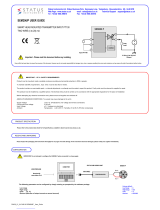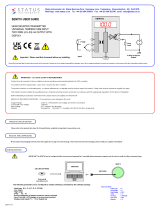
5
Contents
Page
1. Model ............................................................................................................................................................ 7
1.1 Model ....................................................................................................................................................... 7
1.2 How to Read the Model Label ................................................................................................................. 8
2. Names and Functions of Controller ............................................................................................................... 9
3. Mounting to the Control Panel ..................................................................................................................... 12
3.1 External Dimensions (Scale: mm) ......................................................................................................... 12
3.2 Panel Cutout (Scale: mm) ...................................................................................................................... 13
3.3 CT External Dimensions (Scale: mm) ................................................................................................... 14
3.4 Mounting to, and Removal from, the Control Panel ............................................................................... 15
3.4.1 How to Mount the Unit ....................................................................................................................... 15
3.4.2 How to Remove the Mounting Frame and Unit ............................................................................... 17
4. Wiring .......................................................................................................................................................... 18
4.1 Terminal Arrangement ............................................................................................................................ 19
4.2 Lead Wire Solderless Terminal .............................................................................................................. 20
4.3 Terminal Cover ...................................................................................................................................... 21
4.4 Wiring .................................................................................................................................................... 22
4.4.1 Power Supply .................................................................................................................................. 22
4.4.2 Control Output OUT1, OUT2 ........................................................................................................... 22
4.4.3 Input ................................................................................................................................................ 23
4.4.4 Event Output 1, Event Output 2 ...................................................................................................... 24
4.4.5 Insulated Power Output ................................................................................................................... 24
4.4.6 CT Input .......................................................................................................................................... 25
4.4.7 Serial Communication ..................................................................................................................... 27
4.4.8 Event Input ...................................................................................................................................... 29
4.4.9 External Setting Input ...................................................................................................................... 29
4.4.10 Transmission Output ..................................................................................................................... 29
5. Outline of Key Operation and Each Mode ................................................................................................... 30
5.1 key Operation ........................................................................................................................................ 30
5.2 Modes .................................................................................................................................................... 32
5.3 Basic Operation after Power-ON ........................................................................................................... 33
6. Initial Setting ................................................................................................................................................ 37
6.1 Example of Initial Setting ....................................................................................................................... 38
6.2 Initial Setting Mode ................................................................................................................................ 40
7. Settings ....................................................................................................................................................... 53
7.1 Main Setting Mode ................................................................................................................................. 53
7.2 Sub Setting Mode .................................................................................................................................. 58
7.3 Engineering Mode 1 ............................................................................................................................... 64
7.4 Engineering Mode 2 ............................................................................................................................... 79
8. Operation and Settings of Standard Functions ............................................................................................ 80
8.1 Selecting an input type .......................................................................................................................... 80
8.2 Selecting PID Control or ON/OFF Control ............................................................................................. 81
8.3 Selecting Direct/Reverse Action ............................................................................................................ 82
8.4 Performing Fixed Value Control ............................................................................................................. 83
8.5 Setting PID Constants (by Performing AT) ............................................................................................. 84
8.5.1 Usual AT .......................................................................................................................................... 84
8.5.2 AT on Startup .................................................................................................................................. 85
8.6 Performing Auto-reset ............................................................................................................................ 87
8.7 Performing Program Control .................................................................................................................. 88
8.8 Event Output EV1 Allocation .................................................................................................................. 95
8.9 Indicating MV, Remaining Time (Program Control) ................................................................................ 97
8.10 Items to be Initialized by Changing Settings ........................................................................................ 98
9. Attached Function ....................................................................................................................................... 99





















